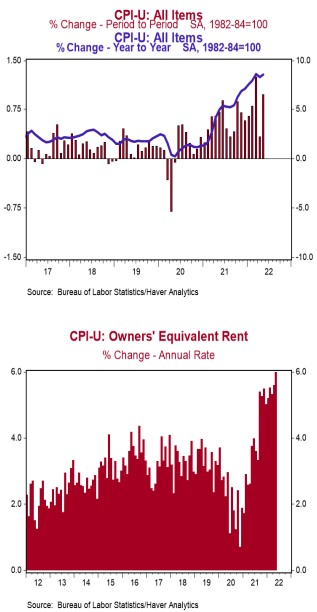- The Consumer Price Index (CPI) increased 1.0% in May, well above the consensus expected +0.7%. The CPI is up 8.6% from a year ago.
- Energy prices increased 3.9% in May, while food prices increased 1.2%. The "core" CPI, which excludes food and energy, rose 0.6% in May, above the consensus expected +0.5%. Core prices are up 6.0% versus a year ago.
- Real average hourly earnings – the cash earnings of all workers, adjusted for inflation – declined 0.6% in May and are down 3.0% in the past year. Real average weekly earnings are down 3.9% in the past year.
Implications:
Clearly inflation is not transitory. Consumer prices soared 1.0% in May, pushing the 12-month increase to a new post-COVID peak of 8.6%, the highest in more than 40 years. "Core" prices rose 0.6%, and are up 6.0% from a year-ago. Looking at the details of today's report, energy prices led the index higher, rising 3.9% on the back of higher costs for gasoline. Geo-political tension in the East and a re-opening of China from strict COVID lockdowns enforced earlier this year means that energy will continue to make an impact on consumer prices for the foreseeable future. Food prices, the other often volatile category, rose 1.2% and were driven by prices for dairy products, which posted its largest monthly increase in fifteen years. Stripping out these two components shows even more substantial inflation pressure. Housing rents (for both actual tenants and the rental value of owner-occupied homes) accelerated in May, rising 0.6%. Expect rents to be a key driver for inflation in 2022 and beyond because they make up more than 30% of the overall CPI and still have a long way to go to catch up to home prices, which have skyrocketed more than 30% since COVID started. Price increases can be seen across a number of service categories as well, such as airline fares (+12.6%), car and truck rental (+1.7%), and hotels/motels (+1.0%). Meanwhile, prices for new autos continue to rise, while used car prices reversed a string of monthly declines, rising 1.8% for the month. No matter where you look or which way you cut it, inflation is high and it has continued to rise. The M2 measure of the money supply soared during COVID and now consumers are paying the price in much higher inflation. Until the Fed gets growth in the money supply under persistent control, high inflation is here to stay. In other recent news on the job market, new claims for unemployment insurance increased 27,000 last week to 229,000. Continuing claims remained unchanged at 1.306 million. Look for further job gains in June.





